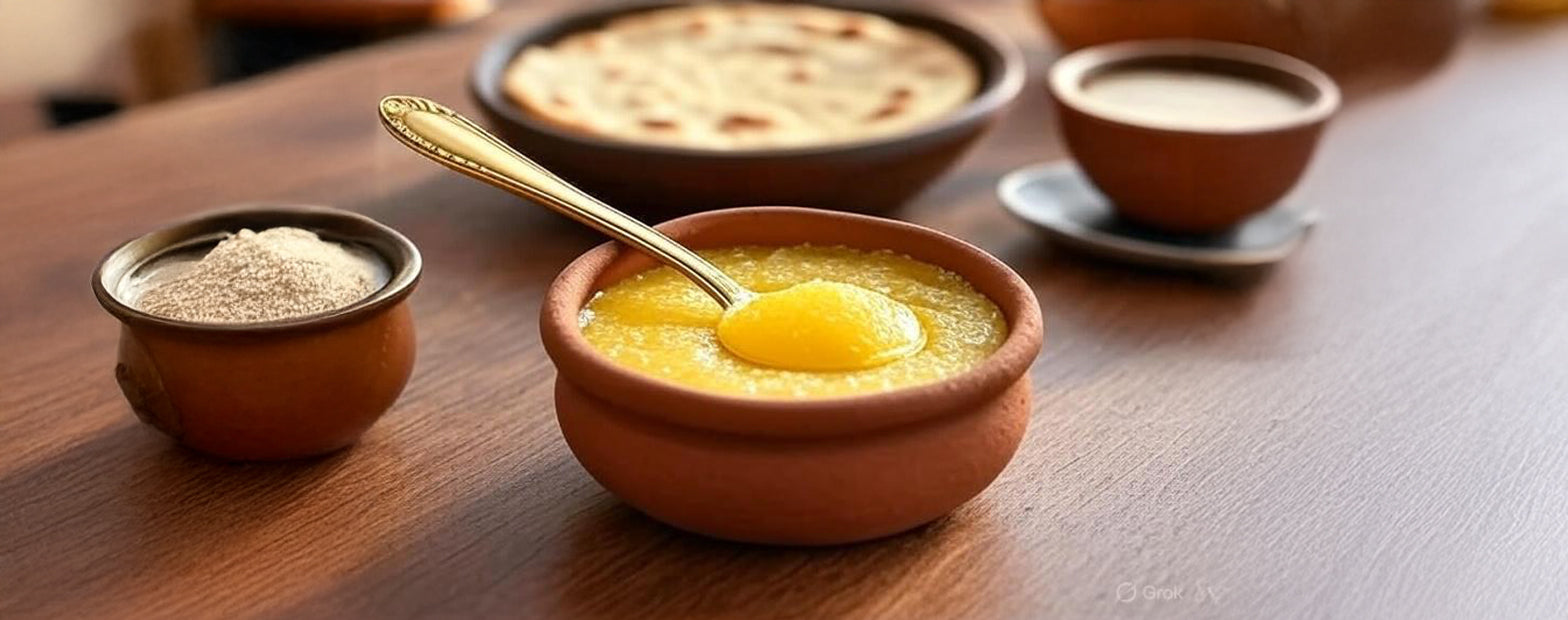
10 Incredible Health Benefits of Adding Ghee to Your Diet
For centuries, ghee has been a staple in Indian kitchens — a golden, aromatic, and nutrient-rich fat that’s more than just a cooking ingredient. Known as “liquid gold” in Ayurveda, ghee has been praised for its healing properties, digestive benefits, and rich flavor.
If you’re part of the Indian diaspora in the USA, you may have noticed that while ghee is now trending in health circles as a “superfood,” it has always been an integral part of our traditional diet. Whether it’s drizzled over steaming dal, spread on hot rotis, or blended into a warm cup of turmeric milk, ghee isn’t just food — it’s heritage.
Let’s explore the 10 incredible health benefits of adding ghee to your diet — backed by both tradition and modern science.

1. Boosts Digestive Health
In Ayurveda, ghee is considered one of the best fats for digestion. It stimulates the secretion of stomach acids, helping break down food efficiently.
Ghee is rich in butyric acid, a short-chain fatty acid that nourishes the intestinal lining and promotes healthy digestion.
Tip for the Indian diaspora: If you’ve been eating more processed or fiber-heavy foods in the U.S., a spoonful of ghee can help soothe your digestive system and improve nutrient absorption.
2. Packed with Healthy Fats
Unlike processed vegetable oils, ghee contains healthy saturated fats that provide long-lasting energy and help balance cholesterol levels.
These fats are crucial for hormone production, brain function, and overall cellular health.
Fun fact: Many American nutritionists now recommend swapping margarine or refined oils with grass-fed ghee for a healthier fat source.
3. Strengthens Immunity
In Ayurveda, ghee is known as Ojas builder — supporting vitality, strength, and immunity. Its butyric acid content has anti-inflammatory properties, helping the body fight infections.
Additionally, ghee is rich in fat-soluble vitamins A, D, E, and K, which are vital for immune function.
Adding ghee to your daily meals can be a simple way to give your body a natural immune boost — especially during winters when colds and flu are common.
4. Promotes Heart Health
Contrary to the outdated belief that all fats are bad, studies now show that moderate consumption of pure ghee can actually support cardiovascular health.
The omega-3 fatty acids in ghee help reduce inflammation and may lower the risk of heart disease.
For the Indian community abroad, where sedentary lifestyles and fast food are common temptations, replacing unhealthy trans fats with ghee can make a big difference.
5. Supports Weight Management
Yes, you read that right — ghee can help with weight management!
The fatty acids in ghee are easily absorbed and quickly metabolized by the body, making them a readily available source of energy rather than being stored as fat.
Ghee also keeps you feeling fuller for longer, reducing cravings for unhealthy snacks.
If you are missing home-cooked Indian meals, adding ghee can make your dishes more satisfying and nourishing.
6. Good for Skin and Hair
For generations, Indian mothers and grandmothers have sworn by ghee as a beauty secret. Consuming ghee internally keeps your skin hydrated and glowing, while applying it externally can soothe dryness and irritation.
The vitamins and antioxidants in ghee also strengthen hair, making it shinier and healthier.
With the harsh winter air and indoor heating, ghee can be a natural remedy for dry skin and hair.
7. Supports Brain Function
Ghee is considered a “brain tonic” in Ayurveda. The healthy fats nourish brain cells, improve memory, and support concentration.
For students and professionals in the Indian diaspora juggling busy schedules, adding ghee to breakfast — perhaps in toast or with oatmeal — can provide sustained mental energy.
8. Balances Vata and Pitta Doshas
Ayurveda teaches that ghee is especially beneficial for people with Vata (dry, cold, light) and Pitta (hot, intense) constitutions. It cools inflammation, lubricates tissues, and provides grounding energy.
If you follow Ayurveda or simply want to feel more balanced in your body, incorporating ghee daily can be transformative.
9. High Smoke Point for Cooking
One practical advantage of ghee is its high smoke point (around 485°F / 250°C), which means it doesn’t break down into harmful free radicals at high temperatures.
This makes it perfect for sautéing, frying, and roasting — a healthier alternative to refined vegetable oils or butter.
10. Cultural Connection and Comfort
Beyond its nutritional benefits, ghee connects us to our roots. For Indians living in the USA, cooking with ghee is a way to keep traditions alive — whether it’s in a festive sweet like halwa or the comforting aroma of tadka dal.
It’s not just food — it’s a piece of home that nourishes both body and soul.
How to Choose the Right Ghee
When buying ghee in the USA, look for:
-
Grass-fed, organic varieties for maximum nutrition.
-
Brands with no added preservatives or artificial colors.
-
Traditional slow-cooked ghee for authentic flavor.
How Much Ghee Should You Eat?

Moderation is key. For most healthy adults, 1–2 teaspoons per meal can provide benefits without excessive calorie intake.
Pair it with whole grains, vegetables, and lean proteins for a balanced diet.
Final Thoughts

Ghee has journeyed from ancient Indian kitchens to modern American health food stores, earning its place as both a cultural treasure and a nutritional powerhouse. For the Indian diaspora in the USA, adding ghee to your diet is more than a trend — it’s a way to honor tradition, nurture health, and bring a little taste of home to every meal.
So, the next time you make dal, khichdi, pasta or even popcorn — don’t forget that golden spoonful of ghee.





